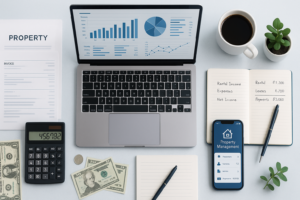
Setting up the financial framework for your rental property business is like creating a detailed roadmap for managing your money. This system’s heart is the Chart of Accounts, a carefully curated list of financial categories.
Just think of it as signposts along the way, guiding you through income, expenses, assets, liabilities, and equity. It’s like having a reliable filing cabinet for your finances, making it easy to categorize and track every financial move your business makes. With this organized structure, you can ensure efficiency and accuracy every step of the way.
Take a look at this article to get a better grasp of the basics behind a rental property chart of accounts.
Chart of Accounts For Rental Property
Let’s break it down: your chart of accounts rental property is a categorized list encompassing every financial label your business utilizes. These accounts track your business’s financial ins and outs, grouped into five core types:
1. Revenues (where you earn money).
2. Expenses (where you spend money).
3. Assets (what you own).
4. Liabilities (what you owe).
5. Equity (invested money or earnings reinvested).
Each account within this chart is classified into a type. Sub-accounts offer deeper details, allowing you to segment transactions while still aggregating them under overarching categories, which is essential for tax reporting.
Tailoring for Multiple Properties
For real estate investors, it’s crucial to keep a close eye on each property’s finances while having a big-picture view of the entire portfolio. Regarding tax reporting, forms like Schedule E require a detailed breakdown of rental income for each property. Simply relying on the chart of accounts rental property won’t provide this level of detail. That’s where accounting systems with classes or tags come into play. They help you manage everything with ease.
These tags work hand-in-hand with the chart of accounts, allowing for segmented financial reports and targeted analysis that provide valuable insights for strategic decision-making.
Creating Your Chart of Accounts For Rental Property
When it comes to accounting software, one of its many benefits is the provision of default charts that cater to the unique needs of various businesses. An efficient approach for rental property ventures is to mirror the IRS Schedule E form, which is a strong foundation for accurate financial reporting. This form, crucial for documenting revenue and expenses annually, is a reliable blueprint ensuring compliance and clarity in the complex world of rental property accounting.
Revenue Accounts
The Schedule E tool simplifies revenue reporting by focusing on one primary account: rents received. But if you want to track and analyze your rental income comprehensively, creating sub-accounts for those extra income sources is a good idea. You know, stuff like application fees, security deposits, or pet rent.
That way, you can customize your accounts to fit your business’s unique needs and quirks. And trust me, having this level of detail and organization will give you a better grasp on your rental income and help you make smarter financial decisions.
Expense Accounts
Schedule E includes fifteen expense accounts that cover everyday property expenses. These accounts encompass maintenance, repairs, and other essential services. To get a more detailed view of your expenses, you can create sub accounts to categorize them further.
For example, you can have sub accounts like “roof repairs” and “HVAC maintenance” to break down specific costs. This way, you can refine your reporting while matching the required categories. Also, an “Other Expense” class can be used for expenses that don’t fit into predefined categories. Remember to provide additional details during tax time for transactions categorized under “Other Expense” to ensure accurate reporting.
Asset Accounts
Property owners, whether individuals or businesses, typically possess dedicated business bank accounts and may also have mortgage escrow accounts. These accounts are vital assets for tracking and managing incoming revenue and outgoing expenses related to their properties.
For property owners who choose to work with property management companies, creating a separate asset account specifically for the manager can further streamline the comparison of financial statement expenses and the differentiation between managerial and personal expenses. This additional detail ensures accurate and efficient financial management for property owners.
Apart from what was mentioned earlier, we also have land, buildings, and improvements as part of the standard asset accounts. These accounts help us keep track of the capitalized improvements and annual depreciation expenses for buildings and improvements.
To accurately monitor the value of these assets over time, we use special accounts like Accumulated Depreciation. These accounts play a vital role in giving us a complete and detailed picture of these assets’ financial status and value.
Liability Accounts
In a property business, you’ll encounter common liabilities involving different financial obligations. These include mortgages, credit lines, and credit cards tied to your property ventures. Another vital thing to remember is the liability account for Security Deposits Held. This account ensures funds are set aside for returning deposits to tenants, following legal regulations and established bookkeeping protocols. Managing these liabilities is essential for maintaining a solid financial foundation in the property industry.
Equity Accounts
Equity accounts, a fundamental component of financial statements, encompass owner contributions and distributions. These accounts effectively trace the flow of money in and out of the business, providing valuable insights into the financial health of an organization.
Retained earnings, representing the cumulative income or losses over time, and net income, indicating the current-period income, are prominently displayed on the balance sheet. Together, they offer a comprehensive snapshot of the financial performance and stability of the business.
Final Touches for Smooth Operations
Propertese is a powerful ERP system, for chart of account for rental property that can significantly simplify the initial setup process for existing businesses transitioning to a more structured accounting system. Automating the entry of starting bank balances, previous capital improvements, prior year income, and other historical transactions streamlines the entire process and saves valuable time and effort. With Propertese, businesses can ensure accurate and comprehensive financial records, setting a solid foundation for future growth and success.
Conclusion
When running a rental property business, having a well-organized and comprehensive Chart of Accounts is crucial. It’s not just about keeping your books in order but also about creating a framework that can be tailored to your specific needs.
By considering tax reporting requirements and diving into detailed accounts, you can effectively manage your finances and gain valuable insights into your business’s performance. This level of attention to financial management will set you up for long-term success and growth in your rental property venture. So, let’s get started and make sure your business is on the right track!
Table of Contents
Stay Updated
Subscribe to get the latest news, industry trends, blog posts, and updates...





